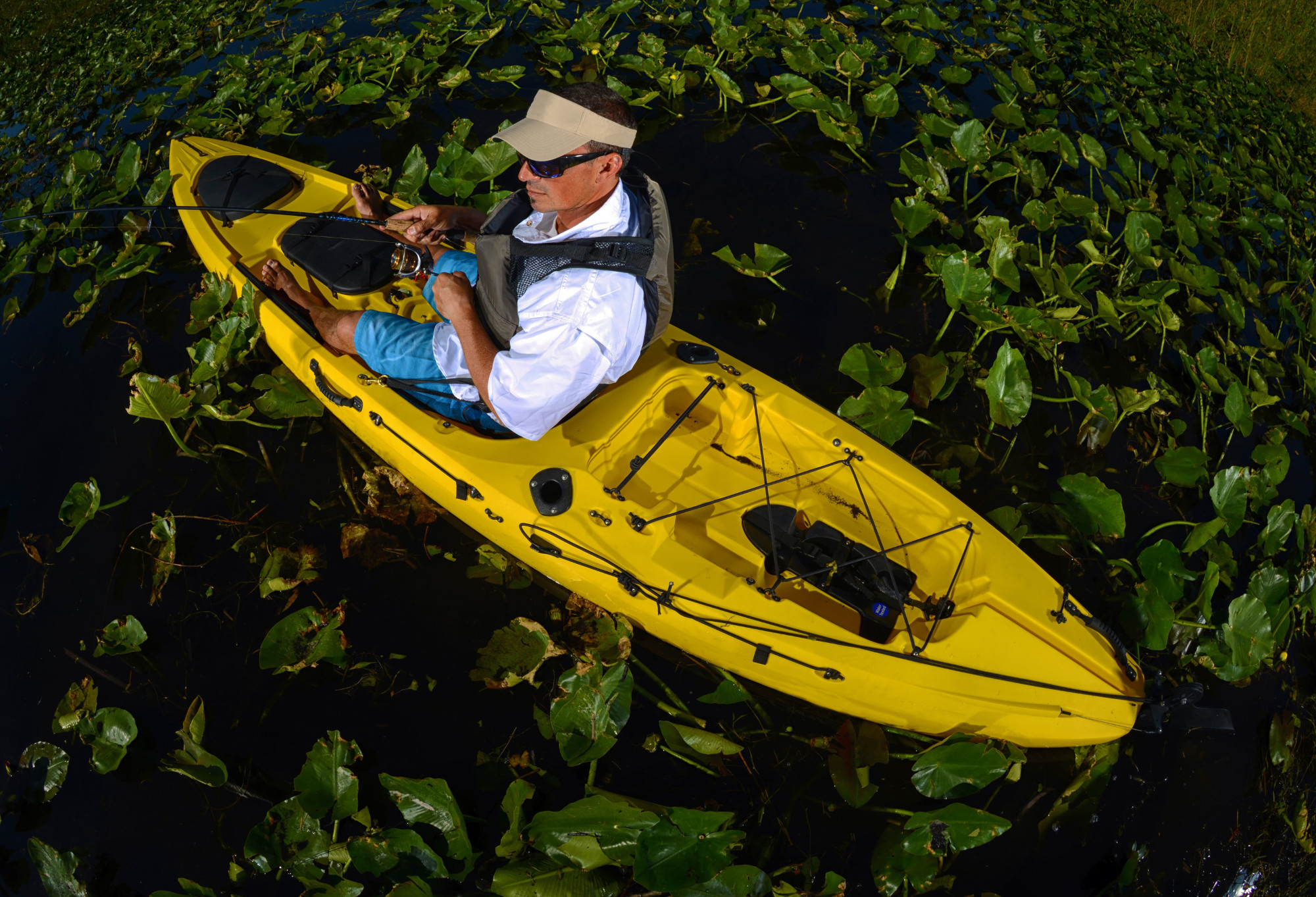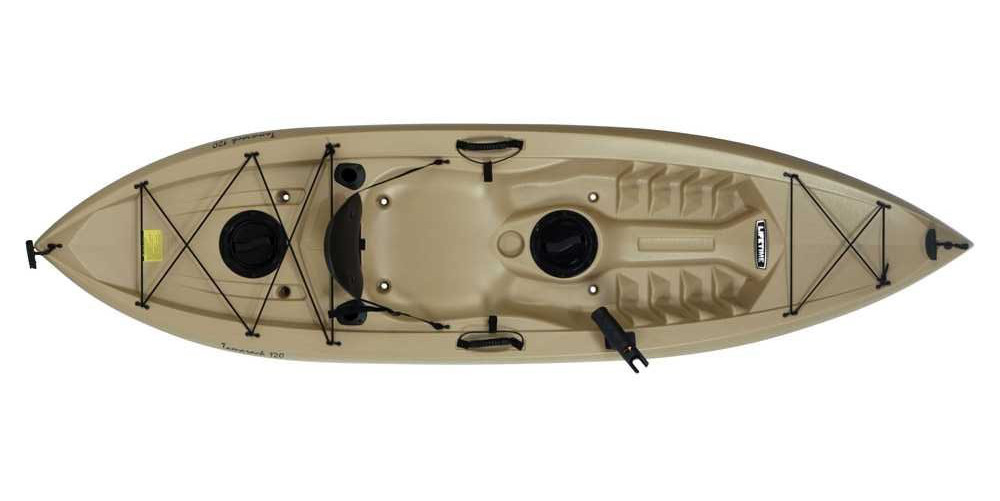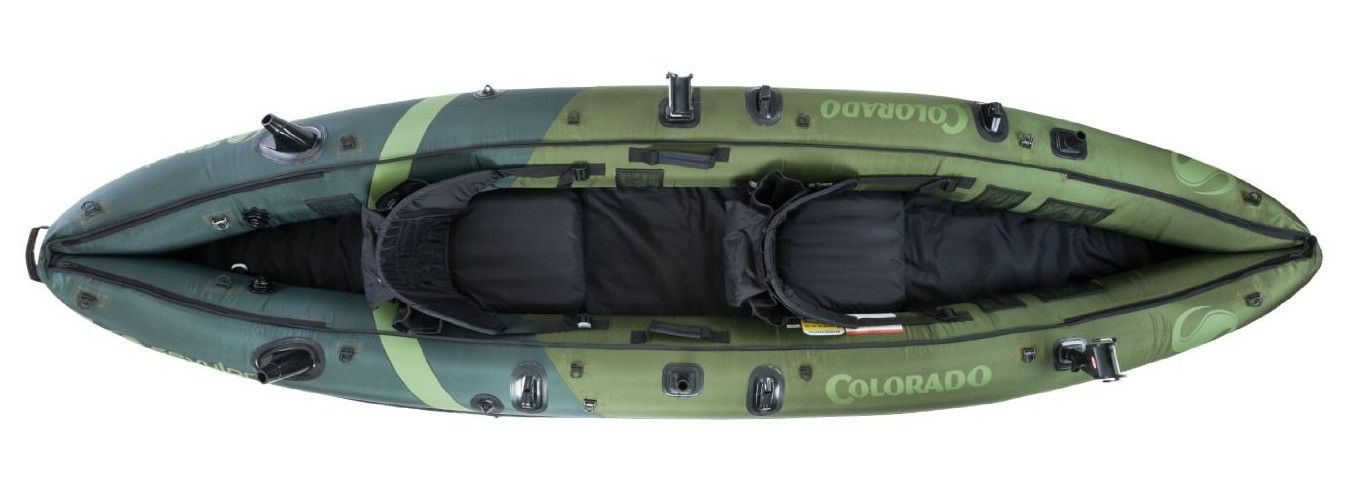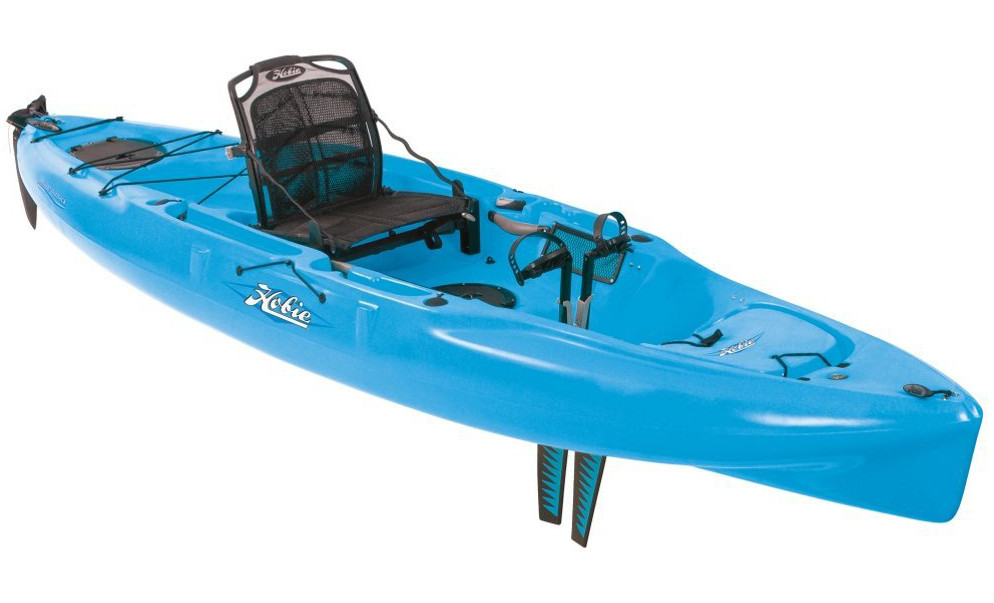Best Kayak For Fishing Reviews 2020 & Buyer Guide

Kayak fishing has become more and more popular in recent years, and for good reason. Using the best kayak for fishing can be a fun change from casting from the shore or shallow water, and depending on the area you’re fishing in, they can be quite useful at accessing caves, areas with cover that you would like to target, or any other nooks and crannies in the area.
In many situations, having a boat is the most ideal, but kayaks offer their own unique advantages that can really appeal to anglers. Some of the most practical advantages when compared with powerboats include lower cost, ease of use, no fuel, and portability. From a very general perspective, you could consider kayaks as a bridge between casting from the shore and ripping around on a powerboat.
While kayaks are cheaper than powerboats, they are still quite expensive in an absolute sense. Therefore, it’s always a good idea to learn as much as you can about them before making a final decision. In this article, https://flannelfishermen.com will provide some important factors to consider when choosing a good fishing kayak for your needs, and given we’re big on value, we will also provide our top picks for kayaks at various price points.
5 Best Kayak for Fishing Reviews
- Basic
- Mid-Range
- High-End
- Pro
- Elite
Lifetime Tamarack Sit-On-Top Fishing Kayak

Pros
- Very low price
- UV-protected HDPE contstruction
- Two flush mounted fishing rod holders, one top mount.
- Two 6-inch storage compartments at rear and center
- Comes with paddle
Cons
- Fairly slow
- Seat back/pad is a bit flimsy
- Average durability, can be dented easier than some other fishing kayaks.
General Consensus
The Lifetime Tamarack SOT fishing kayak is one of the cheaper kayaks out there, especially if you’re looking for something specific to fishing and of at least decent quality. Even though it’s a really cheap fishing kayak, it’s still quite nice and gets the job done well, but you won’t find any advanced or luxury features.
This kayak is 10 feet in length, which is what we would consider to be on the short-average length for a fishing kayak, and is a little wider (31 inches) compared to most fishing kayaks. This means it will move slower, but should have good stability and can be more maneuverable, which is good for smaller bodies of water that are more intricate.
There are two storage compartments, one at the back and one in the center, each of which is about 6 inches in diameter. The SOT design also allows for better use of space inside the kayak, and the seat is adjustable, albeit pretty flimsy. If we were to use this long term, an upgrade to the seat would likely be in order.
Overall, this is a great value fishing kayak that gets the job done, but doesn’t offer many advanced or fancy features. It’s slower mainly due to the length and width, but if you’re planning on using it on smaller bodies of water, that probably isn’t a huge issue. Therefore, we would recommend this fishing kayak for beginners who prefer stability over speed, any angler looking to save as much money as possible, or those who want to learn the fundamentals and their own personal preferences before making a much larger purchase.
Coleman Colorado Two-Person Fishing Kayak

Pros
- 18-guage PVC construction
- 1000D tarpaulin bottom and 840D nylon cover for protection against punctures
- Multiple air chambers for safety
- Designed for two people
- Includes carry bag and pressure guage
Cons
- Does not come with paddles
- Can be a tight squeeze for two larger individuals
- A big person might find it a little narrow, even with only themselves in the kayak
- Seat back is too low for some
General Consensus
The Coleman Colorado Two-Person fishing kayak offers great value and surprisingly durable construction, especially for an inflatable craft at this price. With this inflatable design and at a lower price point, it makes sense that this needs to be a sit-in-kayak (SIK), but this will make it less efficient in terms of space and being able to move around inside the kayak. The dimensions of this kayak are 10’9″ long and 3’3″ wide.
This fishing kayak can easily fit two people, but if the two people are larger individuals, they may find it to be a tighter squeeze. Nevertheless, even if it is a tight squeeze, it’s still comfortable for at least a few hours and the non-rigid design can provide some relief when pushing the limits for space. The main complaint about space or comfort is the seat back is a little too low, but you can bring along your own cushion to help compensate for that as well.
Lots of people think that an inflatable fishing kayak will automatically be worse than a rigidly constructed kayak. While this can sometimes be the case, the Coleman Colorado actually provides good quality construction that offers good performance and surprising durability. The 1000D tarpaulin bottom and 840D nylon cover does a great job resisting any type of puncture, but should something bad happen where a puncture actually does occur, this kayak has multiple air chambers so that when one goes, the rest can carry the load until you get back to shore.
Overall, this is a surprisingly great fishing kayak that offers a nice two-person design at a low price. While some people don’t really like inflatable crafts, this kayak is robust, sturdy, and durable, and also provides the benefit that it can be deflated for storage or transportation. We would recommend the Coleman Colorado two-person fishing kayak for anyone on a budget looking to split the cost with a buddy or any angler who prefers an inflatable kayak.
Ocean Kayak Prowler 13 SOT Fishing Kayak

Pros
- Fast, stable, and quiet
- Large front hatch with easy access
- Rear oversized tank
- Comfort Plus seat
- 6″ hatch with storage bucket
- 2 rod holders, 2 cup holders, 2 paddle keeps, and a skid plate
- Transducer-compatible
Cons
- Moderately expensive
- Paddles purchased separately
- No rudder (one can be added), but very stable anyway
- Center hatch can let a bit of water in
General Consensus
The Ocean Kayak Prowler Sit-On-Top fishing kayak is one of the better performing and more reliable fishing kayaks on the market. The jump up in price from the Coleman Colorado is quite substantial, but so is the quality and design.
This fishing kayak is 12’4″ in length and only 28-inches wide, which makes it a breeze to paddle around in. Narrow kayaks are usually less stable, but in addition to the width, the design also plays a role in stability, and this kayak is actually surprisingly stable. It can also support up to 475 lbs, which is pretty good!
You can tell the Prowler was more thoughtfully designed with the angler in mind. The back storage tank is nice and big and is transducer-compatible, so you can bring along your fish finder. There’s also lots of spots to attach caribeaners, so you can further optimize based on your personal preferences.
Overall, this is a relaible fishing kayak that moves efficiently, provides good stability, has some great features for any fisherman, and is known to be quite durable. Of course, the increase in quality comes with an increase in cost, but it’s still within a normal, maybe normal-to-expensive, price range. We would recommend the Ocean Kayak Prowler SOT fishing kayak to anyone looking for a step up from their basic kayak, those who don’t mind spending a little more for the increased quality, and for any angler who values ample and convenient storage.
Hobie Mirage Outback Fishing Kayak

Pros
- Hobie “MirageDrive”
- Large covered hatch in rear
- Dry bag utility trays cargo area
- Sail mount
- Adjustable high-back padded seat
- Rudder included
Cons
- Really expensive
- Fairly heavy
General Consensus
Now we’re really getting into high performance fishing kayaks. Hobie is known as a great brand for these high-end fishing kayaks, and the Outback is definitely part of that. In our review of the Ocean Kayak Prowler (high-end tab), we mentioned the design appeared more carefully thought out for fishermen. This Outback kayak is the same, except they go the extra mile by introducing some really cool enhancements.
One of the main advantages of the Outback over lots of other fishing kayaks is the MirageDrive system, which is Hobie’s foot pedal propulsion mechanism. This allows you to give your arms a rest and pedal by foot, which can be great if you’re covering lots of water or want to easily fish on the go and move around to lots of different spots.
The Outback fishing kayak comes with a rudder, which can be placed in a locked (down) position. When the water becomes too shallow, you can simply unlock the rudder allowing it to flip up, and then instead of the MirageDrive you would paddle the rest of the way in (this unit comes with a paddle). For added performance, you could even upgrade to a sailing rudder.
The dimensions of this kayak are 12’1″ in length and 33″ in width, which is a nice balance between speed and stability. The Outback also has lots of storage capabilities, similar to the Ocean Kayak Prowler. With rod holders, a gear bucket, dry bag utility trays cargo area, and more, the Outback should be able ot handle all of your needs.
The main drawback to the Hobie Mirage Outback? Cost. These kayaks are really expensive, often double the price of something like the Ocean Kayak Prowler. So while the overall value may not be as pronounced as some of the affordable kayaks, the Outback still includes features that you just can’t find anywhere else for much cheaper, at least that we know of. It’s also a little heavier due to added components and a more robust construction, but that’s not a huge deal, and doesn’t make a difference on the water.
Overall, the Hobie Mirage Outback is an excellent fishing kayak that moves quickly, has some terrific propulsion mechanisms (MirageDrive), is very stable, has lots of storage, and gets the job done time after time. However, it comes at a serious price and some of the features may not benefit you if you don’t fish from a kayak that often. Therefore, we would recommend the Hobie Mirage Outback fishing kayak for serious anglers with previous experience in fishing kayaks, or to those more recreational anglers who want a great kayak and aren’t sticking to a strict budget.
Hobie Mirage Pro Angler Fishing Kayak

Pros
- MirageDrive pedal system
- Adjustable Vantage seating system for enhanced support and overall comfort
- Easy access to tackle
- Horizontal storage for 4 rods, vertical storage for 2 rods
- Tons of storage for gear, ice, or utilizing a live well.
Cons
- Very expensive!
- Heavy
General Consensus
The Hobie Mirage Pro Angler fishing kayak is very similar to the Hobie Mirage Outback fishing kayak, but somehow they managed to further improve upon the Outback’s design. Simply put, this thing is a beast with everything you need and want, but as expected, it’s really expensive, even more expensive than the Outback.
The Pro Angler 14 also uses the MirageDrive pedal system, which is arguably the main feature that sets these kayaks apart from other more conventional fishing kayaks. One feature that isn’t talked about a lot, but can make a huge difference in your experience on the water, is comfort. This padded seat has a high back and is adjustable, which really helps keep you comfortable when spending a long time on the water.
You don’t need to worry too much about the weight capacity, as this thing holds up to 600 lbs! Combined with ample storage capacity, you can bring lots of gear out with you, which again, helps you maximize your time on the water. The 2015 model also comes with a tracing keel, H-Rail mounting system, and a Lowrance Ready fish finder installation system.
The Hobie Mirage Pro Angler 14 fishing kayak isn’t small, as it’s dimensions are 13’8″ in length and 38″ in width, and it weighs about 145 when fully rigged. So while it’s still a breeze to move around on the water, the weight can make it a little difficult to transport.
Overall, this fishing kayak is a beast and has everything you can want or need. This is accompanied by a really high cost, one that many of us cannot afford. Therefore, we would recommend this fishing kayak to very serious or professional angler with lots of experience on the water, or even more recreational anglers that don’t care about the cost and know they will use it a lot.
What to Look in a Best Kayak for Fishing
Understanding your own personal preferences is the biggest help when trying to figure out the best fishing kayak for you. If this is your first kayak and you’re not sure about your preferences, no worries, much of this will be based on your experience and any fishing plans you might have, which can help narrow the choices for you.
Sit-In-Kayak (SIK) versus Sit-On-Top (SOT) Kayaks
There are two main types of fishing kayaks: Sit-On-Top (SOT) and Sit-In-Kayak (SIK). There are a few differences between them whichh we will outline below:
SOT Fishing Kayaks
SOT kayaks are the most common type for fishing. They have an elevated seat/cockpit that sits on top of the kayak, which will allow for better leverage and viewing of the surroundings and easy access to any gear that you have brought along. It’s easier to move around in an SOT kayak, but since you are perched higher up, this will make the kayak less stable overall. Therefore, the trade-off here is that SOT kayaks are often wider to help stabilize the craft, which can make them a little slower compared with SIK kayaks.
SIK Kayaks
SIK kayaks are the standard kayak that paddlers use. These are typically faster and more narrow kayaks, so they can cover a given amount of water a lot more quickly. In terms of fishing, SIK usually offer more storage overall, but you will be a little more constricted, so it can be more difficult to access gear. Additionally, lots of inflatable fishing kayaks are of the SIK variety. This doesn’t mean it isn’t possible to design an inflatable SOT kayak, but if you want to keep costs down, limiting materials and structures that can facilitate a SOT design is sometimes ideal for the manufacturers, as well as the customers.
Overall, we tend to prefer SOT kayaks due to the easy access to less constriction, easier access to gear, and a higher vantage point. While SOT kayaks can be made very stable, this usually cuts down on the speed, but that’s not the main priority for us.
Fishing Kayak Length and Width
Fishing kayaks come in a variety of sizes. The man things that will be affected by length and width of the kayak are speed, stability, and maneuverability. There are other aspects of the kayak that will affect these as well, but length and width play a big role and are quite easy to understand.
Longer and more narrow kayaks tend to be faster. These can cut through the water with less resistance, allowing you to cover more area in a shorter amount of time. However, you may find yourself getting tired more quickly from keeping everything stable, and if you aren’t overly experienced in kayaking, the risk of tipping may not be worth it.
On the other hand, wider kayaks will be a lot more stable, but there is more resistance against the kayak, so it will move slower as well. If you prefer the comfort and peace of mind of a stable kayak, or you’re fishing a small body of water that you don’t need to be constantly ripping around, then this isn’t a problem. But if you’re out with buddies who have faster kayaks and you tend to fish on big lakes, then you might want to consider a more narrow kayak.
Lastly, most fishing kayaks will be maneuverable enough that you can get them where they need to be and in the correct orientation. However, it’s still worth considering the nooks and crannies of your local waters, even if it is a minor point. If you know the body of water that you will be mostly fishing on, think about any specific areas that you know you will want to try and fish. If you need to weave throughout rocks, through small channels, or around aggressive cover, then you might want a smaller overall kayak, but this should be considered a very minor point relative to other things.
Check out this great tutorial about choosing a fishing kayak, with an emphasis on length and width:
Storage
Ample storage capacity and convenience of access is essential in a good fishing kayak. Most fishing kayaks will have good enough storage for the essentials, but having a wider selection of tackle, line, rods, tools, as well as come more comfort items like food, drinks, a phone, a camera, etc, can all make a big difference in how much enjoyment you get out of the day.
When deciding what type of storage arrangement is best for you, we like to adopt the general-to-specific mindset, where we gradually narrow our options based on our loose plans. For example:
– Are you a minimalist and like to pack light? Do you have a small selection of tackle? Do you know that you will only be out on the water for a few hours at a time? If yes to any of these, you may not need abundant storage or quick access if it’s out of the budget.
– If you answered no to those questions, then it sounds like storage is a priority. At his point, you can begin refining the questions you are asking to yourself. If you have lots of gear, do want to bring a lot of it? Are you only fishing for one species, or multiple? If only one species, what are the essential lures and other tackle to have on hand?
Lastly, when reading the specs of a fishing kayak, try and look for storage compartments with specific purposes. Sometimes companies will design compartments or wells that offer more convenient storage. For example, you may see a shallow but wide storage area with a couple bungee boards crossing over top. These are often great for utility trays, so you have a large tackle box with many utility trays, you can potentially have a pres-assigned “kayak tray” that you can very easily add or remove tot he kayak.
Other storage compartments my be waterproof for more sensitive items, some may be designed as live wells for keeping your catch, and some even have extra features wells that are compatible with certain fish finder transducers.
This isn’t to say that you are required to use all of the storage for what they market it for, but usually there’s some thought behind it that will benefit anglers. Simply keeping in mind how different storage compartments could be used will already be a big help in your decision.
Fishing Kayak Seats
This is an often overlooked feature for a first time fishing kayak buyer. Usually companies will say the seat they provide is comfortable and adjustable, but a picture is worth 1000 words. Take a look at the kayak and see how high the back rest goes. If it’s a low cut, it will provide some support, but maybe not enough to keep you comfortable for more than a couple hours. Others will be more robust with a higher-back design, which is much more preferred if possible. As you may have guessed, better seats typically come on better kayaks.
If you find a kayak that fits your needs, but you aren’t sure about the seat, we would recommend contacting the seller to see if the seat can be upgraded or modified. Many angler will go ahead with a seat that isn’t great for them, but then add their own padding or support to it. Obviously this isn’t ideal if you’re already spending a lot on a kayak, but sometimes it’s necessary if you want to balance quality and comfort with cost.
Transportation and Storage
The size, weight, and design of your kayak will affect how you get it to and from your local fishing hole, as well as how you store it at home (or wherever else). Don’t forget to look at the weight, as well as little features like carrying handles. You will also want to make sure that your storage area can fit the kayak, so be conservative when estimating how much space it will take up.
With material science becoming more applicable in everyday life, fabrics and other materials for water crafts are becoming stronger and lighter every year. While an inflatable fishing kayak may not appeal to everyone, it’s always worth a consideration, and inflatable fishing kayaks provide a clear advantage in terms of storage, as they can be deflated and moved into a smaller spot. They can also be transported to the water a little easier, but you will have to bring along a pump as well, or disregard that and pump it up at home before you take off.
Bells and Whistles
Finally, if you have narrowed your choices down to a few different fishing kayaks, take a look for any bonus items or advanced specs. Some fishing kayaks will come with a paddle, some won’t, but they should say either way. Most fishing kayaks will come with rod holders, but they can vary quite a bit in number.
One of the advanced specs that we really like to see is a well or other area that is capable of mounting a fish finder transducer. Some have these specific to certain brands of fish finders, which can be extra convenient if you have that brand. Given how popular fishing kayaks are becoming, we wouldn’t be surprised to see fish finder compatibility eventually becoming standard on lots of kayaks.
Summary
At the end of the day, as long as you put some hard thought into your decision and consider multiple factors, chances are that you’ll have a great experience with your new fishing kayak. The Best kayak for Fishing provides a more intimate approach to fishing, a more accessible approach, and a cheaper approach. Give it a go, and hopefully it will be extremely worthwhile!
